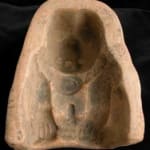Mayan Sculpture Mold, 300 CE - 900 CE
Terracotta
4.5 x 3
PF.6102
Further images
This work of art, an ancient sculptor’s mold, grants us a unique insight into the creative process of Mayan artists. Such a mold would have been used in the fabrication...
This work of art, an ancient sculptor’s mold, grants us a unique insight into the creative process of Mayan artists. Such a mold would have been used in the fabrication of small terracotta sculptures. Pressed into the wet clay, the intricately carved pattern of the mold would be replicated. The highly detailed pattern of the interior belies the soft curves of the abstract exterior. This particular mold replicates the front half of a seated dog. We can presume this creature was a much loved pet of the incarnation of a deity by the beaded necklace he wears with a large central pendant presumably made of jade. Also prominently featured is his elongated nose and jaw, and his clearly defined genitalia, highlighting his fertility. Most likely, the molded clay, while still wet, would have been attached to a back half defining the hindquarters of the dog. This little mold, as functional as it is, was once used to create images of gods and sacred animals. That idols worthy of worship could be created from this mold implies that the mold itself has some inherent power. Clearly, in the hands of a master sculptor, this mold has the power to embody and give form to the gods. Today, this mold is a relic of ancient artistry, transplanted from an ancient Mayan workshop into our hands, linking us directly with the creative process of long forgotten sculptors.







